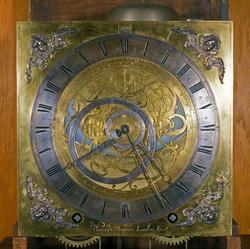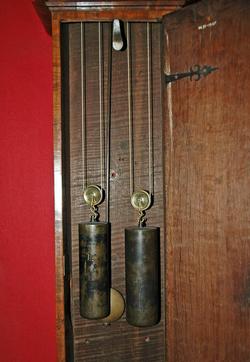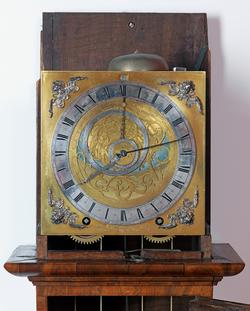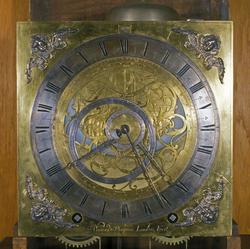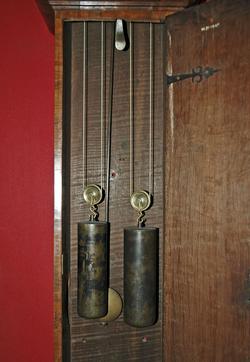Current Location: Gallery 17 (Flower)
Titles
Longcase equation and astronomical clock
Maker(s)
Maker:
Tompion, Thomas
Case maker:
Braem, Jasper
(Probably)
Entities
-
Clock
- longcase equation and astronomical clock
Categories
Description
Oak case veneered with olive wood and marquetry, with ormolu mounts. The movement is of a month duration and has an early form of anchor escapement. It was altered to incorporate an astrolobe shortly after being made.
Dial: gilt dial plate, 10 1/4 inches (26.0 cm) square and silver cherub spandrels. Narrow chapter ring with silver overlay, engraved I - XII twice, with the five minute numbers within the minute divisions and simple half hour markings. The day of the month is shown in a square aperture above the chapter ring. Signed at the base of the dial ‘Thomas Tompion, Londini Fecit'. The whole of the space inside the chapter ring occupied by an astrolabe disc or rete of gilt brass with two applied silver rings. The space behind the rete has lines of equal altitude above a curved horizon line, the empty space between painted in blue, and below it a partially obliterated cartouche and the word ‘crepusculum'. This lower area had at some time been painted blue; this has now been removed. The minute hand of blued steel rotates once per hour and the hour hand, also of blued steel and with a gilt effigy of the sun, rotates once in 24 hours. The third hand, which bears an effigy of the moon, indicates lunar time. The astrolabe disc rotates once per sidereal day and has at its centre a dial which shows age and phase of the moon and high tide at London Bridge. The astronomical indications are discussed in some detail by Symonds.
Movement: Month duration movement with four wheel trains necessitating an indirect drive to the minute hand as with many 30 hour longcase clocks (usually known as "shake minutes"). It is evident that the move¬ment was made for a conventional clock and was modified to accommodate the astrolabe dial; this is shown by the extensions to the plates, provided to carry the indirect winding, necessary to avoid the winding squares fouling the rete, and by spare dial feet holes behind the winding wheels. A very early movement, probably c. 1675-80, not of Tompion's usual quality and with the first form of anchor escapement with undercut front faces to the escape wheel teeth. Bolt type maintaining power is provided but without shutters to the winding holes, these were probably removed when the movement was modified. It has the long crutch and oval section brass pendulum rod typical of Tompion's work. The movement is not numbered.
Case: Oak carcase veneered with olive wood and with olive wood mouldings, with small panels of simple marquetry probably c.1680. According to Dawson who restored the case some years ago, the centre panel in the trunk door is laid over signs of previous chopped-in inlay decoration. Trunk door full width between sides, with battens tongued and grooved, and reproduction hinges. Hood probably reconverted to slide up and with reproduction carved cresting said by Symonds to have probably been copied from the 30 hour Tompion case in Guildhall Museum. Replaced bun feet. Gilt metal Corinthian capitals and bases to plain hood columns and a gilt metal swag above dial opening.
Notes
History note: Mrs V.S. Knox, London; purchased by S.E. Prestige
Legal notes
Given by S. E. Prestige through the National Art Collections Fund
Measurements and weight
Height: 194.3 cm
Height: 76½ in
Width: 26 cm
Acquisition and important dates
Method of acquisition: Given
(1947)
by
Prestige, Sidney Ernest
Dating
17th Century, Late
Charles II
Circa
1675
-
Circa
1680
Note
The movement of the clock is of month duration, and
has an early form of anchor escapement. It was
altered to incorporate the astrolabe shortly after being
made.
School or Style
Baroque
People, subjects and objects depicted
Components of the work
Case
composed of
olive (wood)
oak
Width 10¼ in
Decoration
composed of
silver
Movement
composed of
brass (alloy)
Dial
Height 10¼ in
Inscription or legends present
- Text: Thomas Tompion, Londini Fecit
- Location: Base of dial
- Method of creation: Engraved
- Type: Name
References and bibliographic entries
Related exhibitions
Identification numbers
Accession number: M.21-1947
Primary reference Number: 98110
Stable URI
Audit data
Created: Saturday 6 August 2011
Updated: Monday 25 March 2024
Last processed: Tuesday 13 May 2025
Associated departments & institutions
Owner or interested party:
The Fitzwilliam Museum
Associated department:
Applied Arts
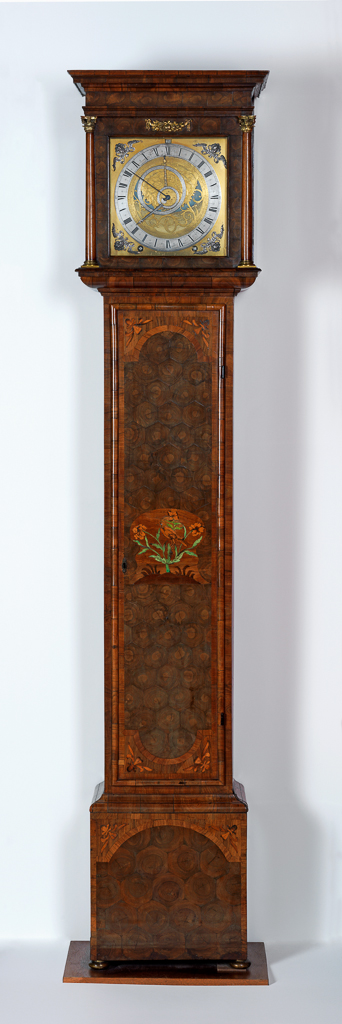
 IIIF Manifest
IIIF Manifest
